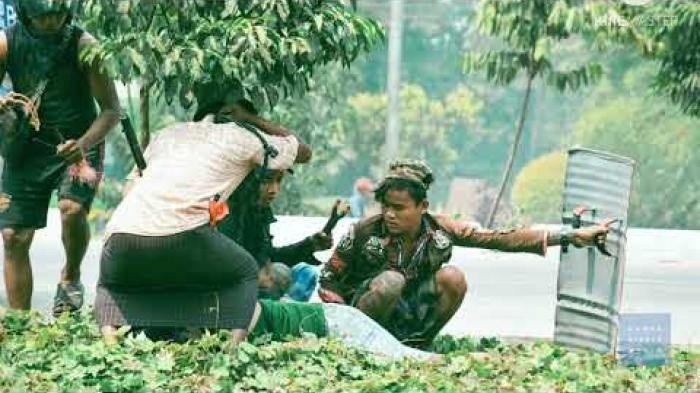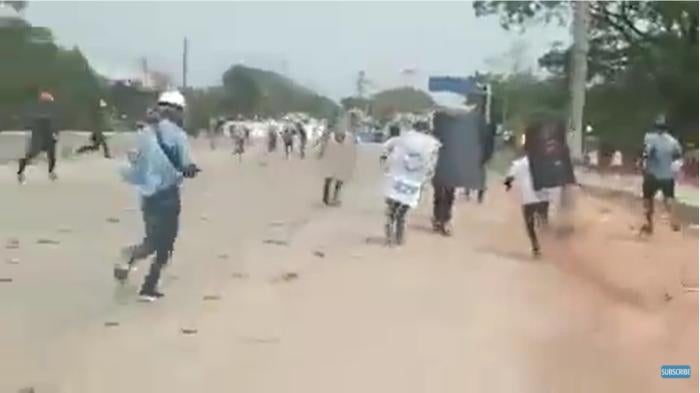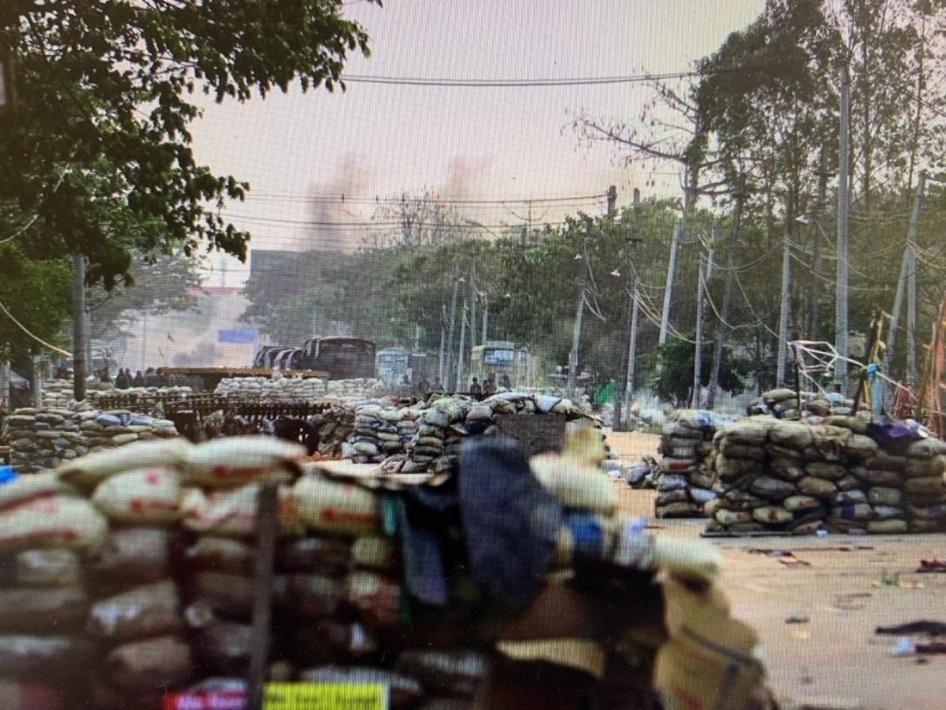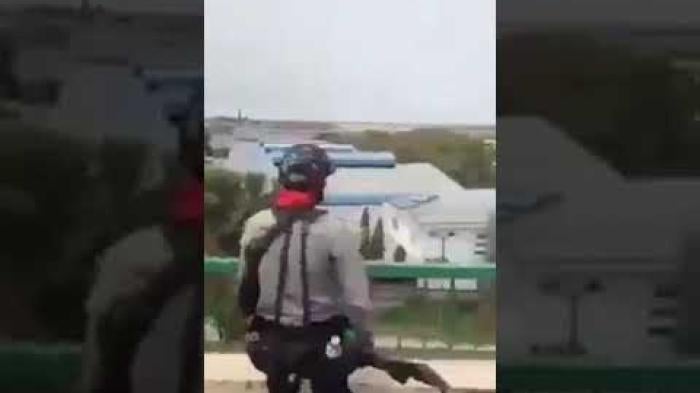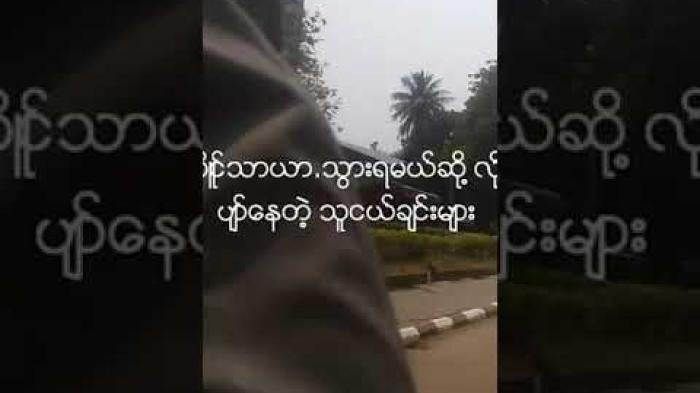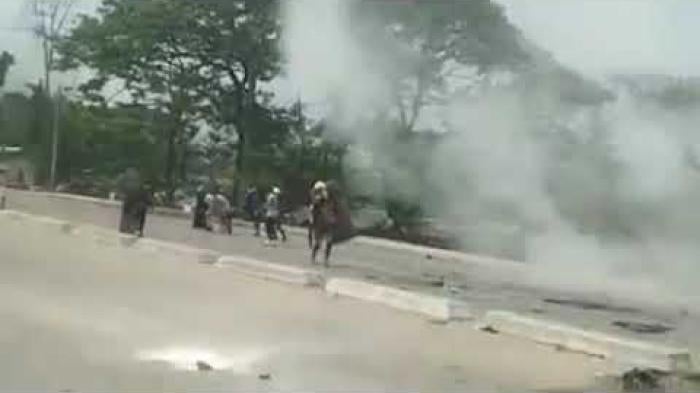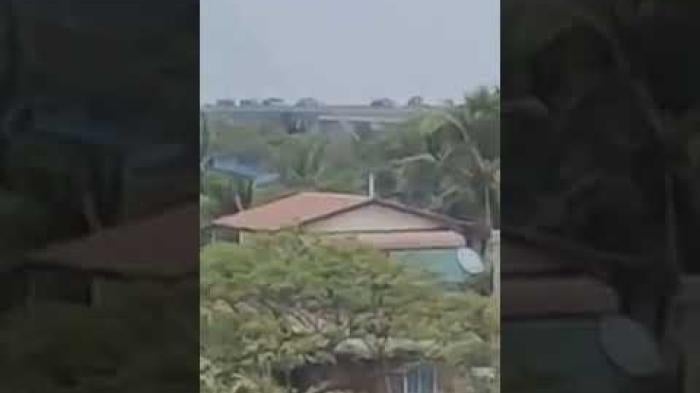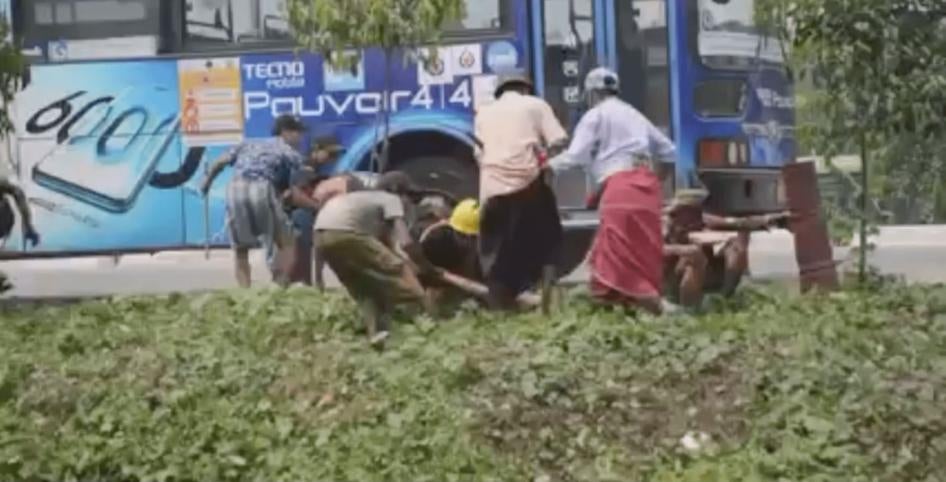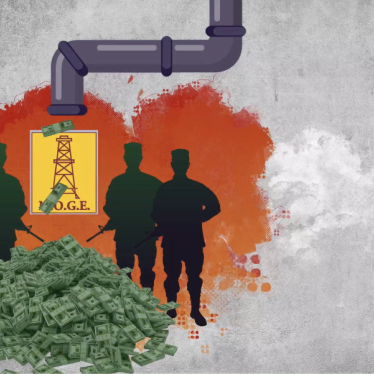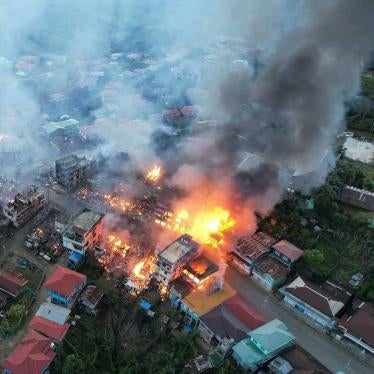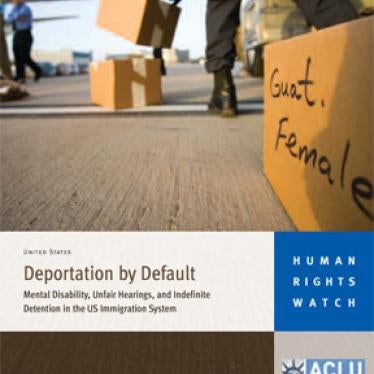(Bangkok) – Myanmar security forces deliberately “kettled” protesters and used lethal force during the March 14, 2021, anti-junta protests in Yangon’s Hlaing Tharyar township, Human Rights Watch said today. Soldiers and police armed with military assault rifles fired on trapped protesters and on those trying to assist the wounded, killing at least 65 protesters and bystanders.
Following the February 1 military coup against Myanmar’s democratically elected government, numerous demonstrations broke out in Yangon and other cities. The police and military forces repeatedly used lethal force against largely peaceful protesters in violation of international human rights law. The deadly shootings in Hlaing Tharyar stand out because of the large number of people killed and the security forces’ apparent premeditated use of lethal force.
“The Myanmar security forces’ massacre of several dozen people outside Yangon in mid-March was not a case of riot control gone astray,” said Manny Maung, Myanmar researcher at Human Rights Watch. “The Hlaing Tharyar killings have the hallmarks of a planned attack on protesters for which those responsible, regardless of rank, should be held to account.”
Human Rights Watch remotely interviewed six witnesses to the Hlaing Tharyar violence. Human Rights Watch also verified 13 videos of the protests recorded on March 14, and 31 photographs uploaded to Facebook, Twitter, or YouTube.
Anti-coup demonstrations began around early March in Hlaing Tharyar, a largely industrial zone across the Hlaing River, west of Yangon. Because many trade union members live and work in the area, the protests were particularly large and well-organized. Before dawn on March 14, protesters set up cement-block barricades and sandbags as barriers at major bus stops along the Hlaing River Road, the area’s main thoroughfare, ahead of sit-in strikes starting at 5 a.m.
Around 10 a.m., about 200 soldiers and police began moving into Hlaing Tharyar, bypassing the barriers and causing protesters to retreat or disperse. Witnesses said that, by 11 a.m., the security forces had trapped many protesters from the east and west, a tactic known in some countries as “kettling.” Only one witness at Mie Kwat Zay said that security forces gave verbal warning before the military and police began firing at protesters, but at all other locations, witnesses heard no warnings.
The witness accounts and videos indicate that security forces deliberately fired upon protesters to kill or maim without there being any threat to the security forces’ lives. One video shows police and military gathered at 1 p.m. on the Aung Zeya Bridge, which separates Hlaing Tharyar from Yangon. The forces look at the protesters on the streets below and can be heard discussing when and whom to shoot. An unidentified person off camera says, “Just shoot them in the head,” while two police officers point assault rifles toward the protesters. Gunshots are heard and the same unidentified person yells, “Shoot! Shoot! Shoot!”
All six witnesses said that the security forces also fired on people who were trying to reach the wounded. “[W]e weren’t able to help those who were injured because they would shoot at us if we tried,” one witness said. “We couldn’t get to them, and they died. Some people who tried to help went forward anyway and they were shot in the head and died.”
Witnesses said that some protesters used weapons, such as rocks, slings, and Molotov cocktails, in response to the security forces firing on them, but no security force casualties were reported.
On March 15, the day after the killings, the junta accused “rioters” of burning down garment factories and blocking firefighters, and imposed martial law in Hlaing Tharyar and nearby Shwe Pyi Thar township. “Rioters created havoc on roads, and over 2,000 rioters also blocked the roads to prevent fire engines from leaving their stations and fighting the fire,” a junta statement said.
The United Nations Basic Principles on the Use of Force and Firearms by Law Enforcement Officials state that security forces should “apply non-violent means before resorting to the use of force and firearms,” and use the minimum necessary force at all times. Firearms may only be used when other less harmful means are not practicable but must still be used to the minimum extent necessary. Intentionally lethal use of firearms is only permitted when strictly unavoidable to protect life. The Basic Principles further provide that in “cases of death and serious injury or other grave consequences, a detailed report shall be sent promptly to the competent authorities.”
Since the coup, throughout the country, Myanmar security forces have killed more than 1,200 protesters and bystanders, committing killings, torture, and other crimes that amount to crimes against humanity. The crime against humanity of murder has been defined by international tribunals as death that “results from an act or omission by the accused, committed with the intent either to kill or to cause serious bodily harm with the reasonable knowledge that it would likely lead to death.”
The State Administration Council, Myanmar’s junta, is not known to have taken any action against security force officers or personnel, for their involvement in criminal offenses at Hlaing Tharyar or as a matter of command responsibility. The military commander with responsibility for the Yangon Region, including Hlaing Tharyar, was Brig. Gen. Nyunt Win Swe. The Yangon Region police chief was Brig. Gen. Myo Min Htike. Former Myanmar military officers told Human Rights Watch that regional military commanders control police forces during joint operations.
The UN, regional bodies, and governments, including the European Union, United States and United Kingdom, should respond to ongoing human rights violations and crimes against humanity in Myanmar by supplementing, strengthening, and coordinating international sanctions against the junta leadership and military under Sr. Gen. Min Aung Hlaing. Actions should include targeted sanctions on specified military and police commanders, including Brig. Gen. Nyunt Win Swe and Brig. Gen. Myo Min Htike; a global arms embargo; and financial restrictions that would reduce the junta’s revenues from extractive industries.
“Hlaing Tharyar was a bloodbath for which all those responsible should be brought to justice,” Maung said. “Such atrocities will continue unless the UN Security Council and concerned governments take concerted action to hold Myanmar’s junta leaders to account.”
For details and accounts of the attacks, please see below.
Killings, Other Abuses in Hlaing Tharyar
In early March protesters set up barricades at several bus stops along the main Hlaing River Road, which runs perpendicular to the Hlaing River. Before dawn on March 14, they gathered at the barriers to participate in sit-ins starting at 5 a.m. By 10 a.m., security forces arrived at the first barricade at Bus Stop 1. Witnesses said that about 200 soldiers and police easily bypassed the barriers, forcing protesters to back up westward along the road, or to disperse north and south into side streets.
By 11 a.m., the security forces came from both east and west and trapped protesters between Bus Stop 3 and Bus Stop 5. Between noon and 12:40 p.m., the security forces encircled or “kettled” the protesters between Bus Stop 1 and Bus Stop 3, based on Human Rights Watch analysis matching key landmarks visible in two videos with satellite imagery, and the length and angle of shadows in the videos.
Witnesses are identified by pseudonyms for their protection.
“Ko Phyo,” who joined the sit-in at dawn at Mie Kwat Zay bus stop near the local market, said that, at about 11:30 a.m., police and soldiers began firing live rounds. They shot continuously, trapping protesters for the next two hours:
At Mie Kwat Zay, a group of soldiers and police joined the ranks from the direction of the BOC [junction] bus stop, and another group from Bus Stop 1 came to trap us in between. The police were at the front and the soldiers were behind them. The soldiers started the shooting.
“Zaw Zaw” said that, at about 11 a.m., security forces started firing at protesters near Bus Stop 5:
They started with teargas and then rubber bullets. After 30 minutes, they started using live rounds. From our side, we used slingshots and rocks, and some even threw Molotov cocktails back … Many people died in front of my eyes … I will never forget that day.
“Zaw Htet,” who had joined a sit-in with other labor rights activists at the Tar Tar Phyu bus stop on Hlaing River Road, said that by 1:40 p.m. at least 50 military trucks had made their way to the Aung Zeya Bridge near the protesters’ barricade. The security forces had overrun other barricades ahead of him. He said that they began to shoot when they reached Tar Tar Phyu. At least two armed security force personnel were positioned on two higher buildings:
Four people got shot at Tar Tar Phyu in front of me. Out of four, three people died on the spot, and another one was carried by taxi to a clinic … A boy next to me was so scared. I told him to stay on the ground and not to get up, but he was so scared, he stood up to run. He got shot in the neck and died.
“Thiri” said that by the time she arrived at Bus Stop 3 around 2:30 p.m., three people were already dead. She could see that others were trapped because of the shooting, but a few were trying to back up from the main road into a smaller road adjacent to the main highway. She could make out two security force personnel on a high building pointing their weapons toward the bus stop, and another two under a tree on the opposite side of the road:
We could see the police and soldiers making their way towards us, bit by bit. So those of us who could started backing off and dispersing towards Bus Stop 5 by trying to go down the alleyways and back streets. That was when they sent [an aerial] drone out to see which way we were running. There weren’t that many soldiers at this point, but they knew which directions all the protesters were taking … Just in front of my eyes, I saw a person get shot in the abdomen and his abdomen burst open.
Myanmar security forces have used low-flying drones during protests elsewhere in the country, in Monywa in Sagaing Region and in Mandalay Region.
“Thiri” said that, shortly after seeing the drone, five more military trucks came over the Aung Zeya Bridge. Running along with four others, security force personnel shot at them, and one bullet hit a nearby lamp post. She fled back and hid behind a barricade at Bus Station 5, but the security forces were also shooting there:
I saw police and soldiers come into the small roads and snatch everyone they saw. I was at Bus Station 5 by then, and I saw they shot at the people who were running and trying to hide behind the barricades. When additional forces came, the combined police and military team moved forward and fired nonstop. I saw another man get shot dead.
“Zaw Zaw” said:
Around 4 p.m., we regrouped at the BOC bus stop. Police and soldiers had attacked other stops ahead, such as at Tar Tar Phyu and Mie Kwat Zay. When we got to the BOC stop, one person was shot with a rubber bullet, and it penetrated their backbone. They even chased us into smaller back streets.
Another protester, “Honey,” said that around 5 p.m., when the sounds of gunfire had died down, she took her motorbike to check on her friends:
That’s when I ran into a sniper shooting from a high building, possibly from Ko Nyi Ma Swe’s phone shop on Hlaing River Road. I had to get off my motorbike and run away. Earlier, there was a guy shot dead. I saw his blood on the road. His body was taken away by residents nearby.
Witnesses said the shooting continued well into the evening. A journalist reported that, at 6 p.m., security forces were still chasing and shooting at protesters near Bogyoke Aung San Road and the Hlaing River Road, near Bus Stop 3.
Deliberate Shooting of Protesters
Witnesses described situations in which they believed the security forces were aiming at and shooting demonstrators. Video that Human Rights Watch analyzed corroborated these accounts.
In one video, recorded around 1 p.m., police and military on the Aung Zeya bridge can be heard discussing who and when to shoot, and where to aim. The suspension bridge is high above the protesters on the ground below, and two police officers on the north side of the bridge can be seen pointing their rifles down toward Bo Ba Htoo Road. Commands are shouted in the background to hold fire as the security forces coordinate when to shoot. Repeated gunshots are then heard off frame.
A police officer posted a video on Tik Tok, which Human Rights Watch analyzed, that shows 11 police officers wearing the distinctive insignia of the Lone Htein riot police, preparing to advance on protesters from a location in Yangon at around noon. As they discuss the weapons they were going to use, one officer says to the others, “You guys will handle Hlaing Tharyar.” Another replies: “I will show no mercy for these people.” Human Rights Watch and others have long documented the highly abusive role that the Lone Htein riot police have played in previous government crackdowns, beating and wrongfully detaining protesters, often working closely beside the army.
Two witnesses said that they heard automatic weapons being used during the crackdown. Both military personnel and police carried military assault rifles that can be fired in a fully automatic mode. A photo posted by a local media outlet shows military officers and vehicles stationed on Hlaing Road between Mie Kwat Zay and the BOC bus stops between 4 and 6 p.m. and a soldier carrying an apparent MA-1 assault rifle. Other photos of police officers on the Yangon side of the Aung Zeya bridge show them using BA series assault rifles.
Videos and images Human Rights Watch reviewed capture the security forces using lethal force against protesters. They also show security forces making a coordinated maneuver to surround protesters and block their exit routes.
In one video, taken just before 12:30 p.m., a group of protesters stand under a row of tarps about 35 meters from Bus Stop 3, as intermittent gunshots can be heard nearby. Soon tear gas is deployed from the west and more gunshots are heard, causing the protesters to disperse to the east.
A second video, filmed one block north of Bus Stop 3 at around 12:30 p.m., appears to show protesters fleeing from gunshots, with tear gas visible about 10 to 40 meters east of the bus stop. A minute later, at least 10 security force trucks are seen in an apparent pincer move, driving west from the Aung Zeya bridge into Hlaing Tharyar toward the retreating protesters. One man is seen lying on the pavement from an apparent gunshot wound to his head. Someone attempts to help him, but gunshots force them to leave the man and run for cover.
Videos corroborate witness accounts that the security forces cut off protesters’ exit routes from the west and the south. A very brief video and two images posted on social media appear to show security forces crossing the Bayint Naung bridge over the Hlaing River, south of Aung Zeya bridge, into Hlaing Tharyar around 3 p.m. Two other photos show at least one bulldozer and two military trucks on an elevated highway roughly a kilometer east of Bayint Naung bridge driving toward Hlaing Tharyar. The one-second video shows three trucks parked at the western end of Bayint Naung bridge. The angle and length of shadows in the video and photos indicate they were taken between 3 p.m. and 3:30 p.m.
Targeting People Trying to Assist the Wounded
Protesters carried injured people to mobile clinics that had been set up around the wards and to a clinic nearby Mie Kwat Zay. However, all six witnesses said they saw security forces prevent injured people from receiving help, and fire on those trying to reach wounded protesters or retrieve dead bodies.
“Yadanar,” a medical student, anticipated violence on March 14 so volunteered at a mobile clinic near Mie Kwat Zay. She said patients started arriving shortly after 1 p.m.:
At least 10 people who came into the clinic were people who’d been shot. They were shot in the arms, legs, head and neck. One person died at our clinic. There might have been other patients who died on their way to a hospital ... When a headshot patient came in, I saw he was having a seizure. We sent him off with an ambulance to a hospital. But one ambulance that took an injured person from our clinic to a hospital was attacked and the ambulance driver badly injured, so they were even shooting at ambulances.
Witnesses said the security forces piled bodies on the back of military vehicles. Other bodies remained on the street because the security forces shot at protesters who tried to retrieve them. The police and soldiers also shot at protesters and health care workers who tried to assist other wounded protesters. Security forces shot a healthcare worker who was trying to retrieve a body just 30 meters away, hitting the healthcare worker in the thigh, a witness said.
Human Rights Watch analyzed a video recorded around noon about 100 meters east of Bus Stop 5 on Hlaing River Road that shows protesters under gunfire as they attempt to carry wounded demonstrators away from advancing security forces. At least four protesters are visibly injured as they try to help others who are shot; one protester is limp and motionless as he is carried away and another is bleeding from his back on the pavement. Teargas is visible in the center of the road. Gunshots ring out throughout the video, and police and military officers are seen advancing west together toward the bus stop.
